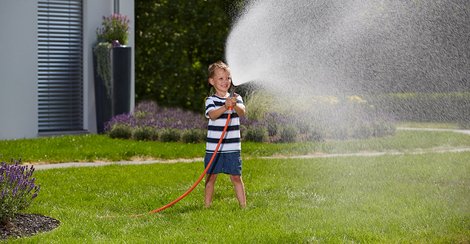Scarifying Your Lawn – Tips and Tricks for Healthy Lawn Care in Spring and Autumn
A well-maintained lawn is the centrepiece of a beautiful garden. However, moss, lawn thatch and compacted soil can severely affect the appearance and health of your lawn. The solution: scarifying your lawn – one of the most important measures in professional and private lawn care.
What is lawn scarifying?
Scarifying involves lightly scoring the turf with a scarifier, a device with rotating blades, to remove moss, lawn thatch, weeds and dead plant debris. This aerates the soil, improves nutrient uptake and stimulates root growth.
Why should you scarify your lawn?
An unkempt lawn quickly develops bare patches, becomes overgrown with moss and loses its resilience. Scarifying improves soil structure, increases oxygen supply, and encourages the growth of fresh, healthy grass.
Benefits of Scarifying
- Removes moss and lawn thatch
- Improves soil aeration
- Enhances absorption of grass seed
- Boosts the appearance and health of your lawn
How to Scarify Your Lawn – Step-by-Step
- Mow the lawn Cut the grass to a height of approx. 2–4 cm.
- Set the scarifier correctly Blades should penetrate the turf to a depth of 2–3 mm.
- Scarify lengthwise and crosswise For best results, scarify in two passes.
- Remove debris Rake up moss and thatch using a rake or leaf broom.
- Reseed the lawn Apply grass seed, especially to bare patches.
Fertilise and water This helps new blades grow and supports quick regeneration.
Tip: A manual scarifier is sufficient for small gardens. For larger areas, an electric or petrol-powered model is recommended.
When should you scarify your lawn?
The right time to scarify depends on the season and soil conditions. In spring, ideally between April and May after the first mow, scarifying ensures a healthy start to the growing season. It is also worthwhile in autumn – around September to October – to prepare the lawn for the cold season and support its regeneration.
Important: The soil should be dry and the lawn should not be cut too short, as damp conditions can damage the turf.
Extra tip: Garden maintenance in autumn – more than just raking leaves
Autumn is not only ideal for scarifying, but also perfect for comprehensive garden maintenance. In addition to the lawn, you should also prepare flower beds, prune shrubs and enrich the soil with compost or organic fertiliser. This will ensure you start the next spring with a healthy garden.
Aftercare – Helping Your Lawn Recover
After scarifying, your lawn will begin its regeneration phase. To ensure that your lawn quickly becomes dense and green again, you should follow these care steps:
Reseed the lawn: Especially in heavily used or bare areas.
Fertilise: A high-quality lawn fertiliser provides the roots with important nutrients.
Water: Keep the area evenly moist, especially for the first two weeks.
Do not walk on it: Give the lawn time to recover and grow back.
Conclusion: Scarifying Done Right
Whether in spring or autumn, scarifying is a key part of lawn care. With the right technique, the right timing and high-quality grass seed, your lawn will become dense, green and resilient again. A well-maintained lawn not only makes your garden more beautiful, but also more resistant to weather and wear and tear.




